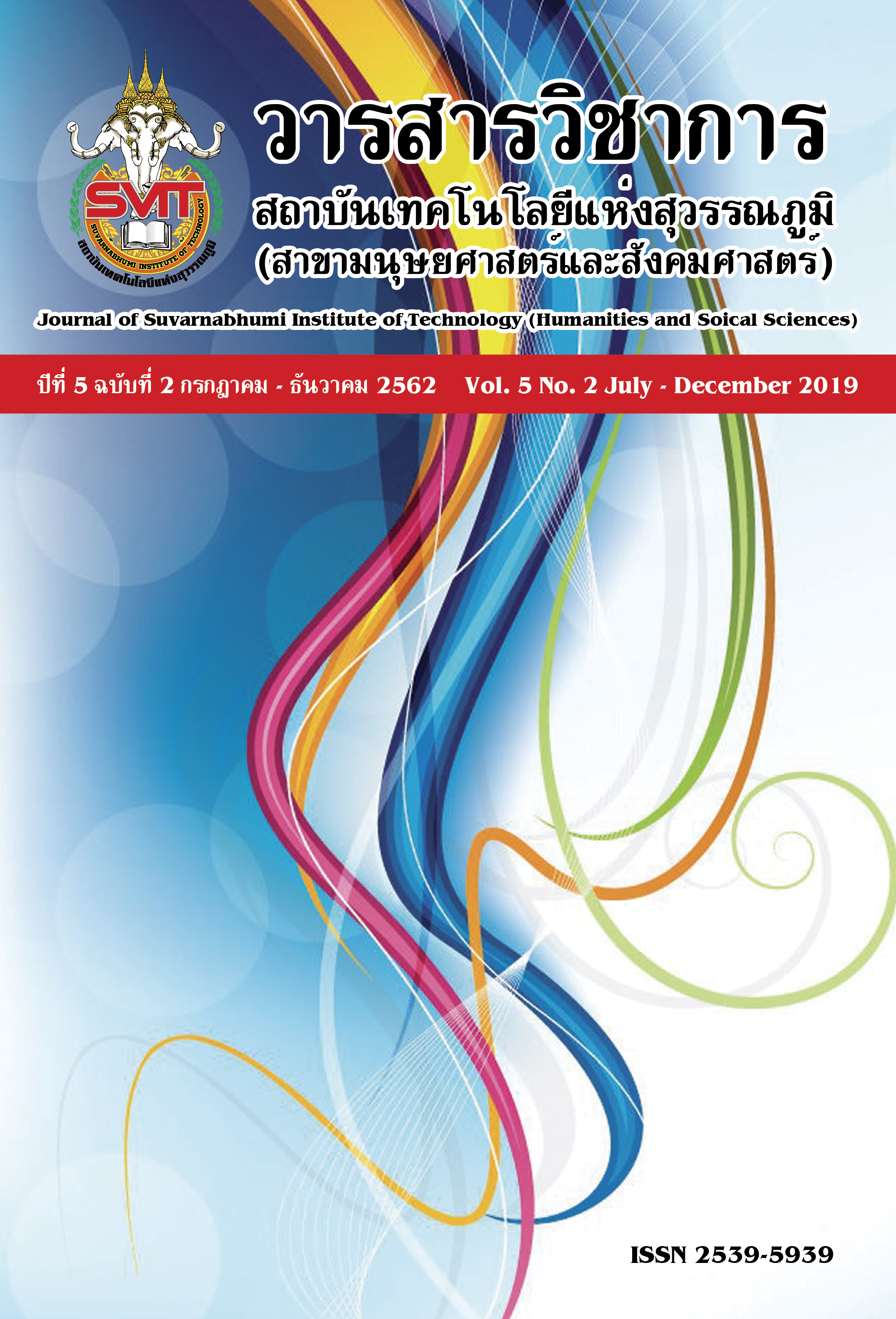THE PROTECTION OF NONTRADITIONAL TRADEMARKS
Keywords:
Trademark, Non-Traditional Trademark, Visually Perceptible, Non-visually Perceptible, Moving MarkAbstract
Nontraditional trademarks can be classified into 2 categories, which are visually perceptible and non-visually perceptible. Moving mark (or multimedia sign) is viewed as visually perceptible, which is not only a movement of certain object, but it also includes a moving image or a movement of brand. Moving mark can be registered as trademark if its graphical representation is sufficient to distinguish a product that a moving mark attached to from other products. Moreover, graphical representation of moving mark is less complicated than other types of nontraditional trademark, and the way the trademark’s owner submits moving mark graphical representation is to represent a sequence of still images with clearly description to each of still image, therefore all of still images are protected under trademark law. Nonetheless, moving mark is not covered by section 4 of Trademark Act B.E. 2534 as amended by the Trademark Act (No. 3) B.E. 2559, which causes a loss of foreign investment in long term. Because of amendment of trademark law in other countries, for example Korea, Singapore, Japan, etc., foreign investors tend to do more investment in those countries comparing to Thailand. Thailand may be implicitly forced to amend trademark law when Thailand come into a bilateral agreement or multilateral agreement with other countries where provide various nontraditional trademarks protection.
References
กฤษฎา ศุภวรรธนะกุล. (2555). แฉไทยลักไก่จ่อจดทรัพย์สินฯ กลิ่น-เสียง ซุ่มแก้กฎหมายรธน.รับเอฟทีเอ.
สหรัฐฯ นักการชี้เสี่ยง-แนะศึกษาให้รอบคอบ. สืบค้นจาก https://tcijthai.com/tcijthainews/view.php?ids=1233.
ข้อตกลงเขตการค้าเสรีระหว่างสาธารณะรัฐเกาหลีกับสหรัฐฯ. (2559). สืบค้นจาก https://ustr.gov/trade-agreements/free-trade-agreements/korus-fta/final-text.
ข้อตกลงเขตการค้าเสรีระหว่างสิงคโปร์กับสหรัฐฯ. (2559).สืบค้นจากhttps://ustr.gov/trade-agreements/free-trade-agreements/singapore-fta/final-text.
ข้อตกลงเขตการค้าเสรีระหว่างออสเตรเลียกับสหรัฐฯ. (2559). สืบค้นจาก https://ustr.gov/trade-agreements/free-trade-agreements/australian-fta/final-text.
พระราชบัญญัติเครื่องหมายการค้า พ.ศ. 2534 แก้ไขเพิ่มเติมโดยพระราชบัญญัติเครื่องหมายการค้า (ฉบับที่ 3) พ.ศ. 2559. สืบค้นจาก https://www.ipthailand.go.th/th/dip-law-2/item.
สมเกียรติ ตั้งกิจวาณิชย์.(2543). การคุ้มครองทรัพย์สินทางปัญญาที่เกี่ยวข้องกับการพาณิชย์อิเล็กทรอนิกส์. สถาบันการวิจัยเพื่อพัฒนาประเทศไทย.
Madrid Protocol. (2016). ASEAN Intellectual Property Portal,. Retrieved from https://www.aseanip.org/Services/Madrid-Protocol.
C-104/01 (ECJ) LibertelGroep BV v Benelux-Merkenbureau
Darani Vachanavuttivong. (2016). Trademark Act Amendments Usher in Thailand’s Accession to the Madrid Protocol, Tilleke&Gibbins. Retrieved from https://www.tilleke.com/resources/trademark-act- amendments-usher-thailands-accession-madrid-protocol.
Katharina Barker. (2013). The Sieckmann Criteria. Retrieve from https://www.lawdit.co.uk/news/365/10/The-Sieckmann-Criteria.
Mitsuko Miyagawa.(2016). Current Situation of Non-traditional Trademark Registration/Japan.
Expert Guides. Retrieved from https://www.expertguides.com/articles/current-situation-of-non-traditional-trademark-registrationjapan/arcvrcwt.
ONEOK, Inc. v Twitter, Inc. (4:09-cv-00597-TCK-TLW)
Roxana Sullivan. (2015). Non-traditional Trademarks through the Lens of the USPTO. Retrieved from https://www.lexology.com/library/detail.aspx?g=7161578b-104c-417e-9a8f-424144f57fdd.
Say Sujintaya and Jomjai Jintas. (2012). Registering Non-traditional Trademarks in Thailand. Retrieved from https://www.nationmultimedia.com/news/opinion/aec/30182973.
Shannon N King. (2000). Brookfield Communication, Inc. v West Coast Entertainment Corp., Berkeley Technology Law Journal, 2000:313.
Steven T Shelton. (2012).Threats to Brands from Social Media. New York Law Journal.
US Watch. (2016). ความสัมพันธ์ด้านเศรษฐกิจไทย-สหรัฐ. Ministry of Foreign Affairs Thailand.
Retrieved from https://uswatch.mfa.go.th/uswatch/en/relationship/economy.
World Intellectual Property Organization (WIPO) (2009). Standing Committee on the Law of Trademarks, Industrial Designs and Geographical Indications (SCT). Retrieved from https://www.wipo.int/sct/en/index.html.
World Intellectual Property Organization (WIPO) (2007). Standing Committee on the Law of Trademarks. Industrial Designs and Geographical Indications - Seventeenth Session: Method of Representation and Description of New Types of Marks. Retrieved from https://www.wipo.int/edocs/mdocs/sct/en/sct_17/sct_17_2.pdf.
World Intellectual Property Organization (WIPO). (2015). WIPO IP Facts and Figures.2015. Retrieved from https://www.wipo.int/edocs/pubdocs/en/wipo_pub_943_2015.pdf.
Yvonne Noorlander. (2016). Motion in Trademark Law: Motion Marks: European IP Update. Retrieve from https://www.nloinfo.nl/documenten/artikelen/uk/motion_in_trademark_law-motion_marks.pdf.
Downloads
Published
Issue
Section
License
บทความที่ได้รับการตีพิมพ์เป็นลิขสิทธิ์ของวารสารวิชาการ สถาบันเทคโนโลยีแห่งสุวรรณภูมิ
ข้อความที่ปรากฏในบทความแต่ละเรื่องในวารสารวิชาการเล่มนี้เป็นความคิดเห็นส่วนตัวของผู้เขียนแต่ละท่านไม่เกี่ยวข้องกับสถาบันเทคโนโลยีแห่งสุวรรณภูมิ และคณาจารย์ท่านอื่นๆในสถาบันฯ แต่อย่างใด ความรับผิดชอบองค์ประกอบทั้งหมดของบทความแต่ละเรื่องเป็นของผู้เขียนแต่ละท่าน หากมีความผิดพลาดใดๆ ผู้เขียนแต่ละท่านจะรับผิดชอบบทความของตนเองแต่ผู้เดียว





